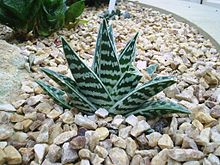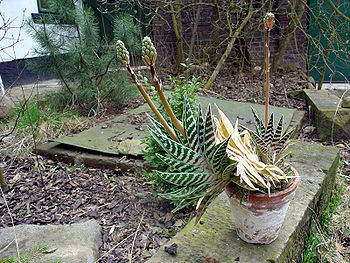- Aloe variegata
-
Aloe variegata 
Scientific classification 
Kingdom: Plantae clade: Angiosperms clade: Monocots Order: Asparagales Family: Xanthorrhoeaceae Subfamily: Asphodeloideae Genus: Aloe Species: A. variegata Binomial name Aloe variegata
L.Aloe variegata, also known as Tiger Aloe and Partridge-breasted Aloe, is a species of aloe indigenous to South Africa and Namibia.
Contents
Description
Plants grow to around 20-30 cm, with 18-24 leaves arranged in three ranks. New leaves appear individually over time from the centre of the plant, flattening older leaves and pushing them outward in a spiral fashion. Each leaf is a rich green colour with irregular light green banding made up of amalgamated, slightly raised oval spots, and similarly light coloured fine serrations along each edge. In mature plants the outer, and thus oldest, leaves are 10-15 cm long and approximately 3-6 cm broad at the base. Depending on trauma, space, water availability or even old age, outer leaves will die off, turning golden brown and shriveling away.
Plants reach maturity in three to seven years, again largely dependent on the space, sunlight and water available, at which point they will begin to send out racemes of flowers. Flowers develop in a cluster at the head of the raceme and are spaced out by its rapid growth.
The flowers are orange, arranged in a raceme of around 20-30 cm in height. Flowers are produced in March and April with offsets being readily formed.
Habitat
In South Africa, this aloe is found in the arid areas of the Western Cape, Eastern Cape, Northern Cape and Free State. It generally grows in rocky terrain and outcrops where they may grow between boulders[1], but may also grow in soils with sharp drainage, such as sandy soils.
History
The first record of this species was an account in the diary of Simon van der Stel (the first Governor of the Cape), when he travelled in 1685 to Namaqualand in the Northern Cape. In addition, this was one of the species cultivated in the Dutch East India Company's garden in Cape Town in 1695.
Ecology
Since Aloe flowers are usually reddish in colour, sunbirds are attracted to these flowers for the nectar they produce, and are likely the plant's main pollinators. Other creatures which visit flowers are usually insects such as bees, wasps, beetles and ants.
References

This Asparagales article is a stub. You can help Wikipedia by expanding it.

